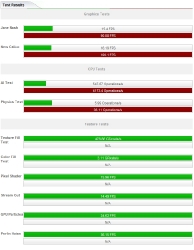3DMark Vantage and PCMark Vantage
Moving on to the synthetic benchmarks, we’ll have a look at 3DMark Vantage, and see what it has to say about the HD 4830.
Running on the Performance preset at 1280×960, we get results in line with what you’d expect from a budget card. With an overall graphics score of 5388, this card places toward the lower end of ATI’s lineup, though it still manages to outperform much of nVidia’s mid-range lineup.
PCMark Vantage is a more general benchmark suite aimed at casual users, but it has a gaming suite of tests as well, so let’s give it a spin and see what we get.
Again, respectable but not stellar.
Cinebench R10
From MAXON:
“MAXON CINEBENCH runs several tests on your computer to measure the performance of the main processor and the graphics card under real world circumstances. The benchmark application makes use of up to 16 CPUs or CPU cores and is available for Windows (32-bit and 64-Bit) and Macintosh (PPC and Intel-based).”
With a GPU score of 3533, the HD 4830 lags behind its next cousin, the HD 4850, which came in at 4085, but still came in ahead of an overclocked GeForce 8800GT tested in the same review, which got a score of 2327.
Lightsmark 2008
From the website:
Realtime global illumination
Natural lighting makes artificial graphics life-like. Computers get faster, but rendering more polygons doesn’t add value if lighting looks faked, so insiders know that the next big thing is proper lighting aka Realtime Global Illumination. Typical workloads in realtime rendering will shift. Lightsmark simulates it. Global Illumination renders often take hours. Is your computer fast enough for realtime?
Lightsmark 2008 offers a quick and easy way to see how your video card copes with HDR lighting at various levels of realism
Running the card through its paces at maximum detail at 1680×1050, we see that the HD 4850 gets an average framerate of 279.2fps, proving that it is more than up to the task.





Actually the 128bit memory interface can indeed compete with one using a 256bit interface depending upon many other factors like overall bandwidth, GPU power, memory type and amount.
I find it hard to believe that a card with a 128bit memory interface can compete with one with 256bit.
Actually, from what I can find, the 4770 ranges from $99-109, whereas the 4830 ranges from $74-109. The 4830 may not be in the same bracket now as when it was released, but it’s still got good bang for the buck.
its difficult to see why you’ve recommended this card, when a 4770 will outperform this one in all benchmarks, and is 10 $ cheaper at the very least.